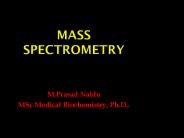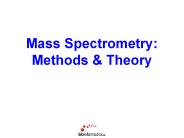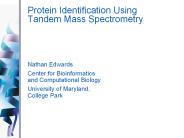Spectrometries PowerPoint PPT Presentations
All Time
Recommended
According to Straits Research, the global mass spectrometry market size was valued at USD 5.35 billion in 2023. It is projected to reach from USD 5.78 billion in 2024 to USD 10.87 billion by 2032, growing at a CAGR of 8.2% during the forecast period (2024–2032). https://straitsresearch.com/report/mass-spectrometry-market/request-sample
| PowerPoint PPT presentation | free to download
Mass Spectrometry Market
| PowerPoint PPT presentation | free to download
The report Mass Spectrometry Market analyzes the Market status, Market share, growth rate, future trends, Market drivers, opportunities and challenges, risks and entry barriers, sales channels, distributors and Porter's Five Forces Analysis.
| PowerPoint PPT presentation | free to download
The Q-TOF (Quadrupole Time-of -Flight) Mass Spectrometry market is expected to grow in the upcoming years due to factors such as rise in applications of spectrometry in pharmaceutical and biotechnology industries and rise in research and development activities in the sector.
| PowerPoint PPT presentation | free to download
Based on technology, the single mass spectrometry market generated more than USD 2.1 billion in 2022. The continuous development of single mass spectrometry technology has led to significant advances in resolution, sensitivity, and data collection speed to help researchers to reach better levels of accuracy, increase productivity, and explore new applications. High sensitivity, quick analysis, and the capacity to run tandem mass spectrometry studies are some other factors propelling the segment growth.
| PowerPoint PPT presentation | free to download
The global mass spectrometry market size reached US$ 5.7 Billion in 2021. Looking forward, IMARC Group expects the market to reach US$ 8.7 Billion by 2027, exhibiting a growth rate (CAGR) of 7.46% during 2022-2027. More info: https://www.imarcgroup.com/mass-spectrometry-market
| PowerPoint PPT presentation | free to download
Data Bridge Market Research analyses that the mass spectrometry market was valued at USD 4.55 billion in 2021 and is expected to reach USD 10.40 billion by 2029, registering a CAGR of 10.90% during the forecast period of 2022 to 2029. https://www.databridgemarketresearch.com/request-a-sample/?dbmr=global-mass-spectrometry-market
| PowerPoint PPT presentation | free to download
The global mass spectrometry market size reached USD 4.36 Billion in 2021 and is expected to register a revenue CAGR of 6.1% during the forecast period, according to latest analysis by Emergen Research. Increased spending by pharmaceutical companies on research & development activities is a major factor driving market revenue growth. These research activities are also facilitating developments and drawing in investments in biopharmaceutical and personalized medicine.
| PowerPoint PPT presentation | free to download
The mass spectrometry market size is expected to grow from an estimated USD 4.1 billion in 2020 to USD 5.6 billion by 2025, at a CAGR of 6.5% during the forecast period. Increasing spending on pharmaceutical R&D across the globe, government regulations on drug safety, growing focus on the quality of food products, increase in crude and shale gas production, and growing government initiatives for pollution control and environmental testing are high growth prospects for the mass spectrometry market during the forecast period.
| PowerPoint PPT presentation | free to download
Global Mass Spectrometry Market growth at a CAGR of 10.90% during the forecast period of 2022 to 2029 and the mass spectrometry market was valued at USD 4.55 billion in 2021 and is expected to reach USD 10.40 billion by 2029. In the field of biological sciences, mass spectrometry is a strong analytical tool. This process uses electrons to identify unknown compounds and components in a sample and to measure recognised compounds. Charged electrons are used in mass spectrometry to convert the contents of a sample into positive ions after joining it. Get Full Access of Report @ https://www.databridgemarketresearch.com/reports/global-mass-spectrometry-market
| PowerPoint PPT presentation | free to download
Mass spectrometry (MS) is an analytical technique that is used to measure the mass-to-charge ratio of ions. This technique basically studies the effect of ionizing energy on molecules. It depends upon chemical reactions in the gas phase in which sample molecules are consumed during the formation of ionic and neutral species.
| PowerPoint PPT presentation | free to download
Porter’s Five Forces analysis examines the competitive structure of the global spectrometry market and would assist market strategists in their decision-making process
| PowerPoint PPT presentation | free to download
Phosphorescence is susceptible to O2 and collisions with solvent molecules. ... For many molecules phosphorescence can only be observed at low temperatures in ...
| PowerPoint PPT presentation | free to view
Ion chromatography mass spectrometry market offers wide applications in food, pharmaceutical, biotechnology industries helps in process validation and clinical testing of protein identification and quantitative analysis of drugs, pharmacokinetics, proteomics, biomarker discovery, food nutritional composition testing, environment testing and others. Wide application and demand of mass spectrometry in drug discovery have augmented the market growth.
| PowerPoint PPT presentation | free to download
Rely on Fisher Chemical’s LC-MS solvents to meet challenging Chromatography applications. LC-MS is a routine technique used in sample analysis that combines Liquid Chromatography (LC) with Mass Spectrometry (MS).
| PowerPoint PPT presentation | free to download
The aim of the study was to evaluate the impact of biofield energy treatment on isotopic abundance ratios of 2H/1H, 13C/12C, (PM+1)/PM and 18O/16O, (PM+2)/PM, in toluic acid isomers using gas chromatography-mass spectrometry (GC-MS).
| PowerPoint PPT presentation | free to download
The objective of the present study was to evaluate the effect of biofield energy treatment on the isotopic abundance ratios of PM+1/PM, and PM+2/PM in o– and m-nitrophenol using the gas chromatography-mass spectrometry.
| PowerPoint PPT presentation | free to download
The stable isotope ratio analysis has increased attention day-by-days in several fields such as agricultural, food authenticity, biochemistry, medical research, etc. The current study was aimed to evaluate the effect of the biofield energy treatment on the isotopic abundance ratios of 13C/12C or 2H/1H or 17O/16O (PM+1/PM) and 18O/16O (PM+2/PM) in TMB using GC-MS technique.
| PowerPoint PPT presentation | free to download
The isotopic abundance ratio analysis of indole using GC-MS revealed that the isotopic abundance ratio of PM+1/PM in the biofield energy treated indole at T1 and T2 was significantly decreased by 44.28 and 28.18% as compared to the control sample.
| PowerPoint PPT presentation | free to download
The p-DCB was divided into two parts – one part was control sample, and another part was considered as the treated sample which was subjected to biofield energy treatment (The Trivedi Effect®).
| PowerPoint PPT presentation | free to download
The p-DCB was divided into two parts – one part was control sample, and another part was considered as the treated sample which was subjected to biofield energy treatment (The Trivedi Effect®).
| PowerPoint PPT presentation | free to download
Source: Chapter 10, Skoog, Holler, and Nieman, Principles of Instrumental Analysis – PowerPoint PPT presentation
| PowerPoint PPT presentation | free to download
The isotopic abundance ratio analysis of indole using GC-MS revealed that the isotopic abundance ratio of PM+1/PM in the biofield energy treated indole at T1 and T2 was significantly decreased by 44.28 and 28.18% as compared to the control sample.
| PowerPoint PPT presentation | free to download
The aim of the study was to evaluate the impact of biofield energy treatment on isotopic abundance ratios in aminopyridine derivatives using gas chromatography-mass spectrometry.
| PowerPoint PPT presentation | free to download
The aim of the study was to evaluate the impact of biofield energy treatment on isotopic abundance ratios in aminopyridine derivatives using gas chromatography-mass spectrometry.
| PowerPoint PPT presentation | free to download
Chapter8, Skoog, Holler, and Nieman, Principles of Instrumental Analysis – PowerPoint PPT presentation
| PowerPoint PPT presentation | free to download
universidade estadual do cear disciplina: an lise prote mica prof . dr. arlindo moura mass spectrometry maldi tof-tof silvio c sar gomes de lima
| PowerPoint PPT presentation | free to download
Chapter 11, Skoog, Holler, and Nieman, Principles of Instrumental Analysis – PowerPoint PPT presentation
| PowerPoint PPT presentation | free to download
... Gas Chromatography MS separates volatile compounds in gas column and ... small molecules, 1-1000 Daltons, structure Fast Atom Bombardment (FAB Semi ...
| PowerPoint PPT presentation | free to download
Presentation Outline. Proteomics : an introduction. Case study 1 : N. vitripennisvenomics. Biological objectives. Experimental set-up. Results. Outline. PhD. defense ...
| PowerPoint PPT presentation | free to view
CH 908: Mass Spectrometry Lecture 8 Collisionally Activated Dissociation (of proteins and peptides) Prof. Peter B. O Connor Collisionally Activated Dissociation ...
| PowerPoint PPT presentation | free to view
Protein Identification Using Tandem Mass Spectrometry Nathan Edwards Center for Bioinformatics and Computational Biology University of Maryland, College Park
| PowerPoint PPT presentation | free to download
Title: PowerPoint Presentation Author: DSP Last modified by: chickosj Created Date: 11/16/2004 11:26:06 PM Document presentation format: On-screen Show (4:3)
| PowerPoint PPT presentation | free to download
Mass Spectrometry To here! From here Molecular Weight: 70 amu Molecular Formula: C5H10 Detection of ionic species to determine the molecular weight of and obtain ...
| PowerPoint PPT presentation | free to download
CH 908: Mass Spectrometry Lecture 6 Mass Analyzers Prof. Peter B. O Connor
| PowerPoint PPT presentation | free to view
Pulsed Glow Discharge Mass Spectrometry: An Ionization Source for Aerosol Analysis and Laser Sampling Farzad Fani-Pakdel Qualifying Examination University of Florida ...
| PowerPoint PPT presentation | free to download
CH 908: Mass Spectrometry Lecture 9 Electron Capture Dissociation of Peptides and Proteins Prof. Peter B. O Connor
| PowerPoint PPT presentation | free to view
Protein Identification Using Tandem Mass Spectrometry Nathan Edwards Informatics Research Applied Biosystems
| PowerPoint PPT presentation | free to download
CH 908: Mass Spectrometry Lecture 4 Interpreting Electron Impact Mass Spectra Continued Recommended: Read chapters 8-9 of McLafferty Prof. Peter B. O Connor
| PowerPoint PPT presentation | free to download
Mass spectrometry L.O.: Use molecular ion peaks and fragmentation peaks to identify structures
| PowerPoint PPT presentation | free to view
Title: PowerPoint Presentation Author: Richard Kelley Last modified by: Gill A. Pratt Created Date: 6/15/2002 8:17:08 PM Document presentation format
| PowerPoint PPT presentation | free to view
Title: PowerPoint Author: Handsome Yu Last modified by: Created Date: 10/26/2001 12:27:17 AM Document presentation format:
| PowerPoint PPT presentation | free to view
... motif decomposition of the phosphotyrosine proteome Mass spectrometry-based proteomics Mass spectrometry-based ... Isotope Labeling with Amino ... Peptide ratio ...
| PowerPoint PPT presentation | free to view
Mass Spectrometry-Based Methods for Protein Identification Joseph A. Loo Department of Biological Chemistry David Geffen School of Medicine Department of Chemistry ...
| PowerPoint PPT presentation | free to download
Title: PowerPoint Presentation Author: CityU Last modified by: Dr. XU Zhengkui Created Date: 2/7/2001 9:29:49 AM Document presentation format: On-screen Show (4:3)
| PowerPoint PPT presentation | free to view
CSE182-L13 Mass Spectrometry Quantitation and other applications
| PowerPoint PPT presentation | free to download
Using Reflectance Spectrometry to Identify Compositions Credit: NASA/JPL-CalTech/LANL Credit: NASA/JPL-CalTech How Do We See Mars? How Do We See Mars?
| PowerPoint PPT presentation | free to download
Chapter 15 Molecular Luminescence Spectrometry Chapter 15 Molecular Luminescence Spectrometry A very sensitive and selective instrumental technique with some of the ...
| PowerPoint PPT presentation | free to view
21D Ion Spectroscopic Techniques Secondary-Ion Mass Spectrometry (SIMS) To determine both the atomic and the molecular composition of ...
| PowerPoint PPT presentation | free to view
Using Reflectance Spectrometry to Identify Compositions Credit: NASA/JPL-CalTech/LANL Credit: NASA/JPL-CalTech How Do We See Mars? Our eyes, cameras, and mission ...
| PowerPoint PPT presentation | free to download
Mass Spectrometry II Isotopes: HRMS and recognition of isotope patterns High Resolution - HR MS Determination of exact mass using HR MS has mostly supplanted ...
| PowerPoint PPT presentation | free to download
Mass spectrometry (MS) is a systematic technique that ionizes chemical species and classified the ions on their mass-to-charge ratio. In other terms, a mass spectrum measures or calculate the masses within a sample.
| PowerPoint PPT presentation | free to download
M = mass of the peak of interest. ? m = width in daltons of the peak ... on the size distribution of peptide masses as a function of protein mass. ...
| PowerPoint PPT presentation | free to download
... generated from high energy x-rays originating from the microscope illumination system bathe ... Scanning Electron ... 4.9 from xray.optics ...
| PowerPoint PPT presentation | free to view
























































